EFT Server provides an AS2 Partner Access wizard to assist you in configuring AS2 outbound connections. This wizard is accessible from the AS2 Outbound partner configuration tab and the AS2 Send File to host Action dialog box (in Event Rules). Once completed, the data in the wizard populates the relevant fields on the AS2 Outbound tab and the AS2 Send File to host Action dialog box. The procedure below describes how to use the wizard to configure outbound AS2 partners. You can also configure the account manually on the AS2 Outbound tabs for each partner.
|
|
If you plan to execute a command upon success or
failure of AS2 transactions, define the
command before configuring your partner access; or you can go
back later and edit the AS2 partner manually after you have defined the
command. |
To configure outbound AS2 partners using the wizard
In the Administrator, connect to EFT Server and click the Server tab.
Do one of the following:
In the left pane, click the user account that you want to configure, then in the right pane, on the account's Connections tab, select the AS2 check box, and then click AS2 Outbound. The AS2 Outbound Settings dialog box appears.

In an Event Rule, after adding the AS2 send file to host action to a Rule, click select. The AS2 Send File dialog box appears.

Click Setup Wizard. The AS2 Partner Outbound Wizard appears.
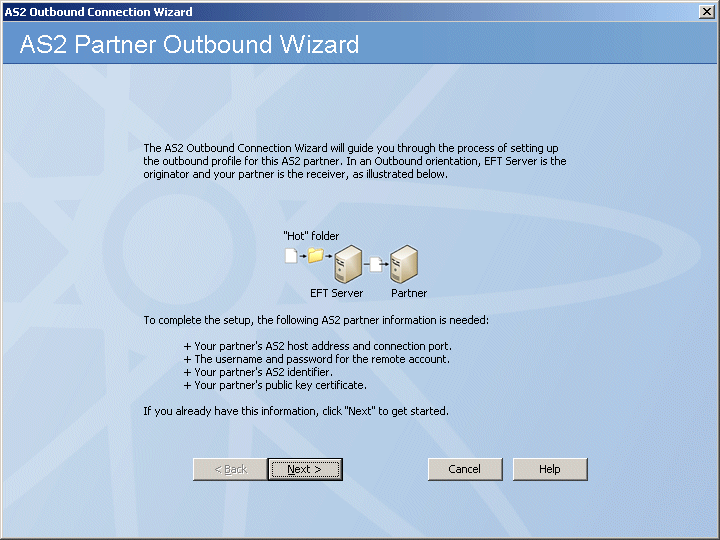
Click Next. The AS2 partner connection information page appears.

In the Partner host address or domain area specify the protocol to use (http:// or https://), IP address/domain name, and Port number used to connect to the AS2 partner. (Some large organizations post their AS2 connection information online, such as the Vendor Directory at http://www.ec-bp.biz/joomla/component/option,com_wrapper/Itemid,100/.)
In the Remote path area, provide the path to the inbox or mailbox at the AS2 partner location.
In the Username and Password boxes, provide the logon credentials.
If you need to configure a proxy server, click Proxy and then refer to Configuring an AS2 Outbound Proxy for the procedure, if necessary.
Click Next. The AS2 certificates page appears.
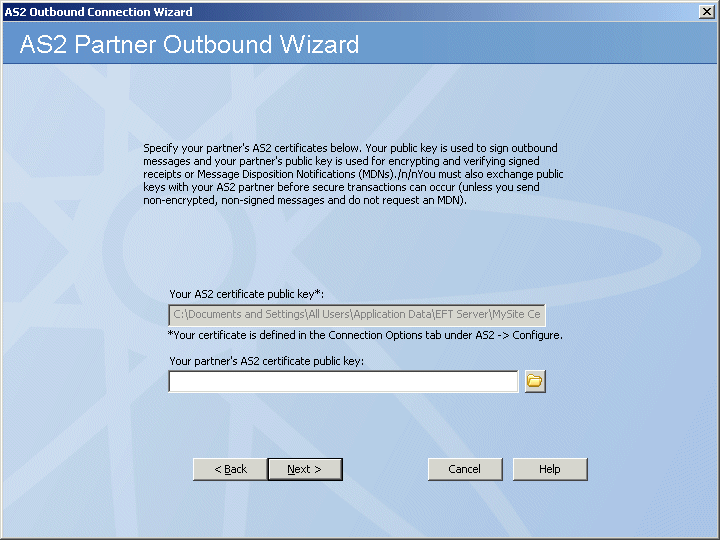
In the Your AS2 certificate public key box, the certificate that you specified when you created the Site appears.
In the Your partner's AS2 certificate public key box, type the path or click the folder icon to select your partner's public key file.
Click Next. The AS2 identifier page appears.
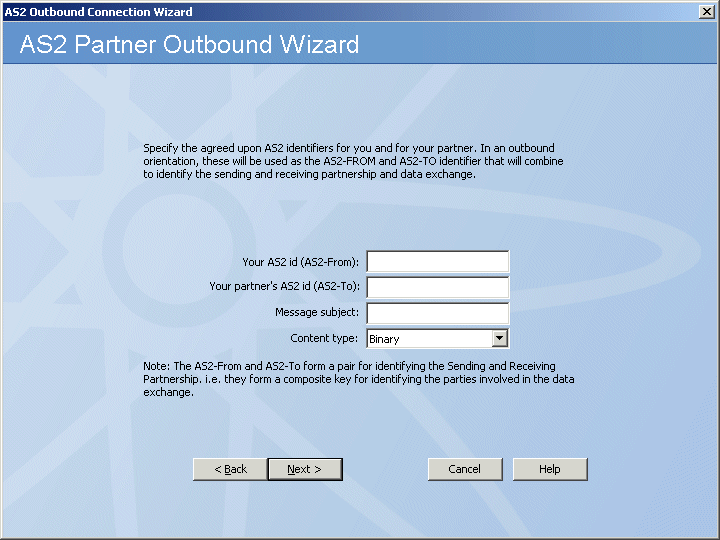
In the Your AS2 ID (AS2-From) box, your globally defined ID appears. You can use the same ID you defined for EFT Server when you enabled the AS2 inbound listener or you can define a different ID for each partner.
In the Your partner’s AS2 ID (AS2-To) box, specify this partner's ID (provided to you by the partner that you are defining).
|
|
AS2-From and AS2-To form a pair for identifying the sending and receiving partnership. That is, they form a composite key for identifying the parties involved in the data exchange. |
(Optional) In the Message subject box, specify the text that is to appear in the subject line of AS2 messages to/from this partner.
In the Content type box, click the list to specify the type of messages to be sent to/from this partner.
X12 - Format used by many health care, insurance, government, transportation, and finance organizations.
EDIFACT - Format adopted by the International Organization for Standardization (ISO) as the ISO standard ISO 9735.
XML - File format used for structured documents.
EDI Consent - Provides a standard mechanism for "wrapping" the EDI objects but does not specify any details about those objects.
Binary (default) - e.g., executables, word processing files, database, spreadsheet, and multimedia files
Plaintext - e.g., text and HTML files
|
|
For information about the various content types, refer to RFC 2046 at http://www.ietf.org/rfc/rfc2046.txt. |
Click Next. The message and receipt options page appears.
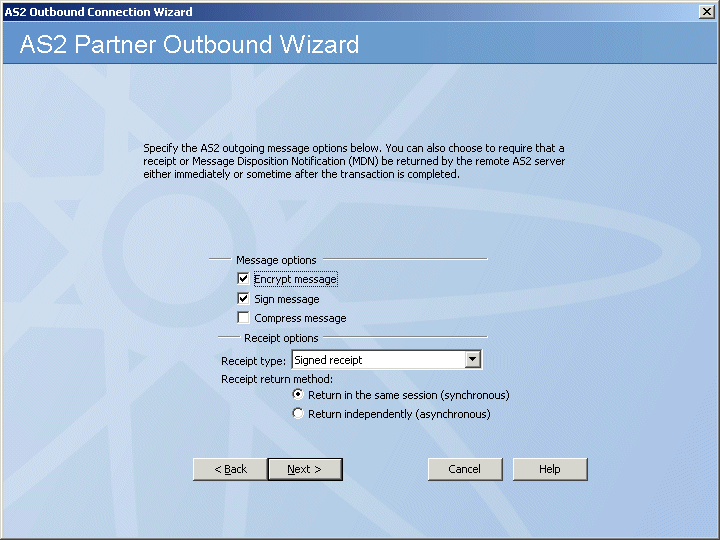
In the Message options area, select or clear the check boxes depending on whether the AS2 message should be encrypted, signed, and/or compressed.
In the Receipt options area, click the list
to specify whether to send a Signed receipt
(Message Disposition Notification (MDN)), an Unsigned
receipt, or no receipt (None).
The MDN serves as a receipt, guaranteeing the transaction was successful.
The receipt can also be signed, and you can specify whether to return
the receipt immediately (synchronous MDN) or later (asynchronous MDN)
if the remote Server must post-process the message prior to acknowledging
the received data.
If you clicked Signed or Unsigned (not None), specify whether to send the receipt in the same session (synchronous) or independently of the session (asynchronous).
Click Next. The message retry and timeout options page appears.
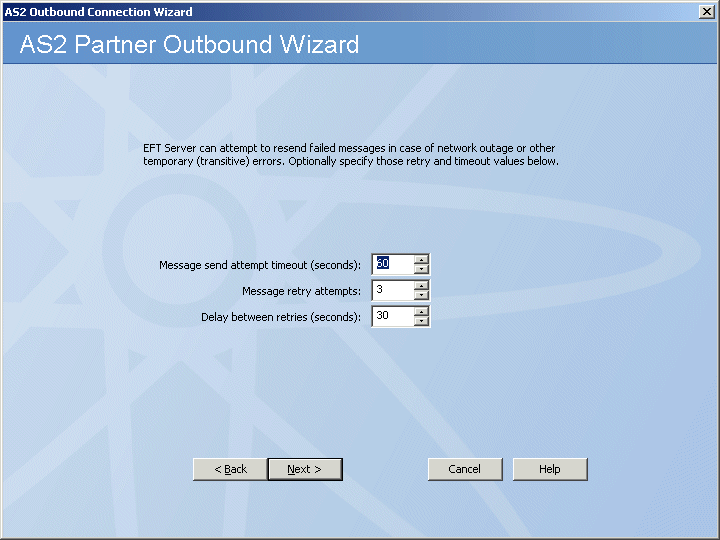
(Optional) EFT Server can attempt to resubmit failed messages in case of network outage or other temporary (transitive) errors. EFT Server will resend the same message, payload, and AS2 Message ID. Specify the following retry and timeout values as needed:
Message send attempt timeout (seconds). The range is 0-600; 0 = no timeout; the default value = 60 seconds.
Message retry attempts. The range is 0-9999; (0 = no retry); the default value = 3 retries.
Delay between retries (seconds). The range is 0-9999; (0 = no wait); the default value = 30 seconds.
Asynchronous receipt timeout (minutes). The range is 0-999,999; (0 = no timeout); the default value = 7200 minutes (5 days). (This option does not appear if you specified synchronous on the previous page.)
Click Next. The commands and notifications page appears.
Click Next. The Test Connection page appears.
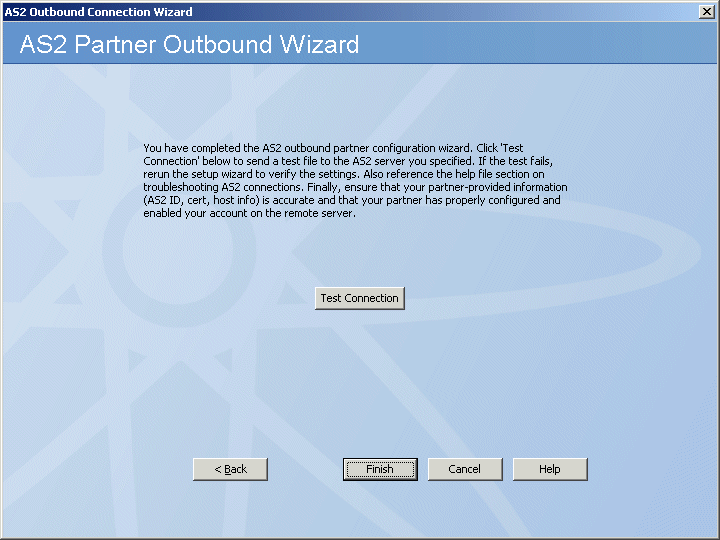
Click Test Connection. The AS2 Test Connection dialog box appears.

EFT Server attempts to connect to the AS2 partner and send test data.
If the test fails, data appears in the AS2 connection log area that you can copy to the clipboard to be pasted in a text file or e-mail for troubleshooting. Click Close, then in the wizard click Back to adjust settings, if necessary.
If the test is successful, click Close.
Click Finish. The information provided in the wizard is updated in the account's AS2 Outbound tab. To make further adjustments to the partner's configuration, you can edit the AS2 Outbound tab directly.